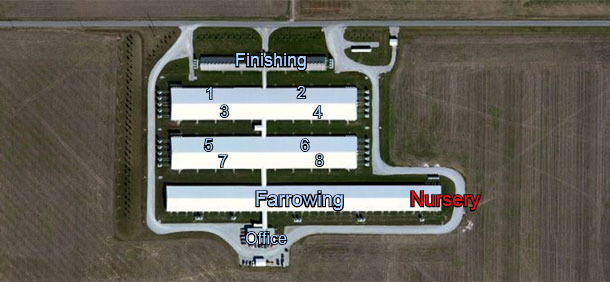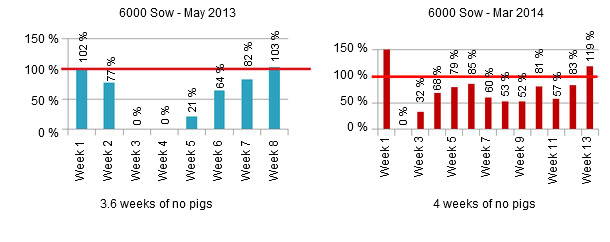PEDV outbreak, May 2013
In May 2013 a sow farm in Indiana (USA) broke with PEDv. The entire farm (including onsite internal multiplication gilts in the nursery and finisher) was given Live Virus Exposure (feedback). This farm lost 3.6 weeks worth of pigs over an 8 week period. Follow-up fecal testing (30 litters per week for 4 consecutive weeks of negative results – Morrison et al, 2013) was successfully completed in September 2013.


All during this time, gilts were retained on site (internal multiplication) and were potentially exposed to virus in the nursery and finisher. Once the 4 weeks in a row of negative fecal were completed, oral fluids were collected from the nursery and finisher showing that those locations had also gone PEDv negative (October 2013).
The next 6 months of production went well (102 % of previous wean pig output) with minimal signs of scours (of any kind) throughout the unit.
Table 1. PEDv results – PCR fecal (F) and intestines (Int)
| Outbreak week | Outbreak days | Production week | Calendar date | 6000 sows |
| 1 | 7 | 19 | May 5 to May 11 | Pos – F & Int |
| 2 | 14 | 20 | May 12 to May 18 | Pos – Int |
| 8 | 56 | 26 | Jun 23 to Jun 29 | Pos – Int |
| 10 | 70 | 28 | Jul 7 to Jul 13 | Pos – F |
| 14 | 98 | 32 | Aug 4 to Aug 10 | Pos – F |
| 15 | 105 | 33 | Aug 11 to Aug 17 | |
| 16 | 112 | 34 | Aug 18 to Aug 24 | |
| 17 | 119 | 35 | Aug 25 to Aug 31 | |
| 18 | 126 | 36 | Sep 1 to Sept 7 | Neg – swabs |
October 2013 - IFA results & Oral fluids
|
PEDv re-brake, March 2014
In mid March 2014, scour were observed in the onsite nursery and finisher. In the subsequent week, PEDv was diagnosed of the same strain (99.9 % homology) and the virus moved into the farrowing house. The entire farm was re-given Live Virus Exposure (LVE).
|
During the LVE, gilts were about the only thing that responded clinically. Sows appeared to be immune to the challenge. We didn’t worry much about this since we assumed the sows would have systemic immunity and the gilts in the breeding barn may or may not have been exposed to PEDv in the nursery or finisher over the July to October 2013 time frame, though gilts prior to July most likely would have been exposed to PEDv.
Over the next 2 weeks in the farrowing house, PEDv only seemed to hit parity 1 & parity 2 litters at about 70% and 50% mortality respectively. In the subsequent weeks, PEDv spread into litters of all parities.
A comparison of the previous 2013 outbreak vs the loss over the 13 weeks until recovery is shown in graph 1.

Graph 1: Average wean numbers during outbreak period and percent of 52 week prior.

Those losses by parity are shown in graph 2 and the comparison with previous PEDv break in graph 3.

Graph 2: Pre-wean mortality by parity - 9 weeks.

Graph 3: Pre-wean mortality by parity - 9 weeks vs previous PEDv break.
As time rolls on, the losses by parity have become more consistent, meaning that PEDv is affecting all parities closer to the same in weeks 11 and 12.
Summary:
My key points from this information:
- This is just one herd. Our other herds have not re-broke.
- PEDv can recur after 6 month of clinical absence.
- I don’t know if this is recrudescence or a re-exposure
- While I had hoped that gilts feedback would be immune and able to protect their subsequent offspring in the face of a challenge, I am less sure of that today. (Implications on gilt acclimation strategies.)
- Despite this crews experience and “expertise” on how to handle PEDv — it has gone chronic in this herd despite excellent people, facilities and sanitation.
My point in sharing this information, is:
- To make people aware that PEDv can re-break.
- There are research opportunities for lactogenic immunity especially as it pertains to the gilt.
- Because of these chronic and recurring situations, we have even more need for vaccine.



